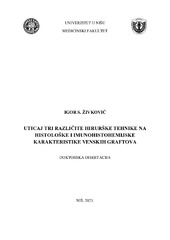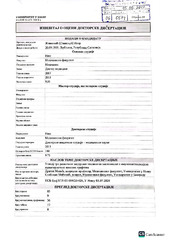Приказ основних података о дисертацији
Uticaj tri različite hirurške tehnike na histološke i imunohistohemijske karakteristike venskih graftova
| dc.contributor.advisor | Milić, Dragan | |
| dc.contributor.other | Mićović, Slobodan | |
| dc.contributor.other | Putnik, Svetozar | |
| dc.contributor.other | Krstić, Miljan | |
| dc.contributor.other | Velinović, Miloš | |
| dc.creator | Živković, Igor | |
| dc.date.accessioned | 2024-02-07T15:04:49Z | |
| dc.date.available | 2024-02-07T15:04:49Z | |
| dc.date.issued | 2023 | |
| dc.identifier.uri | http://eteze.ni.ac.rs/application/showtheses?thesesId=8647 | |
| dc.identifier.uri | https://fedorani.ni.ac.rs/fedora/get/o:2153/bdef:Content/download | |
| dc.identifier.uri | https://plus.cobiss.net/cobiss/sr/sr/bib/126040585 | |
| dc.identifier.uri | https://nardus.mpn.gov.rs/handle/123456789/22215 | |
| dc.description.abstract | Background and Objectives: The saphenous vein is one of the most common used grafts (SVG) for surgical revascularisation. The mechanism of the SVGs occlusion is still unknown. Surgical preparation techniques have an important role in the early and late graft occlusion. Our study analyzed the influence of the three different surgical techniques on the histological and immunohistochemical characteristics of the vein grafts harvested by three different techniques. Methods: Between Jun 2019 and December 2020, 83 patients who underwent surgical revascularization were prospectively randomly assigned into three groups according to saphenous vein graft harvesting (conventional (CVH), notouch (NT) and endoscopic (EVH)) technique. The vein graft samples were sent on the histological (hematoxylin-eosin staining) and immunohistochemical (CD31, Factor VIII, Caveolin and eNOS) examinations. Results: the CVH, NT, and EVH groups included 27 patients (mean age 67.66±5.6), 31 patients (mean age 66.5±7.4) and 25 patients (mean age 66±5.5), respectively. Hematoxylin-eosin staining revealed a lower grade of microstructural vein damage in the NT group (2, IQR 1-2) in comparison with CVH and EVH (3, IQR 2-4), (4, IQR 2-4) respectively (p <0.001). Immunohistochemical examination revealed a high grade of staining in the NT group compared to the CVH and EVH group (CD 31 antibody p=0.02, FVIII, p<0.001, Caveolin, p=0.001, and eNOS, p=0.003). The best preservation of the structural vein integrity was in the NT group, while the lowest rate of leg wound complication was in the EVH group. Those facts increase the interest in developing and implementing the endoscopic no-touch technique. | en |
| dc.format | application/pdf | |
| dc.language | sr | |
| dc.publisher | Универзитет у Нишу, Медицински факултет | sr |
| dc.rights | openAccess | en |
| dc.rights.uri | https://creativecommons.org/licenses/by-nc-nd/4.0/ | |
| dc.source | Универзитет у Нишу | sr |
| dc.subject | Aortokoronarni bypass, Histologija, Imunohistohemija, Klasična priprema vene, No-touch, Endoskopska priprema vene | sr |
| dc.subject | CABG, Histology, Immunohistochemistry, Conventional vein harvesting, No-touch, Endoscopic vein harvesting | en |
| dc.title | Uticaj tri različite hirurške tehnike na histološke i imunohistohemijske karakteristike venskih graftova | sr |
| dc.type | doctoralThesis | |
| dc.rights.license | BY-NC-ND | |
| dc.identifier.fulltext | http://nardus.mpn.gov.rs/bitstream/id/159437/Doctoral_thesis_14915.pdf | |
| dc.identifier.fulltext | http://nardus.mpn.gov.rs/bitstream/id/159438/Zivkovic_Igor_S.pdf | |
| dc.identifier.rcub | https://hdl.handle.net/21.15107/rcub_nardus_22215 |



